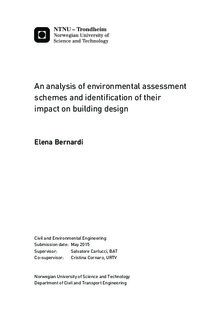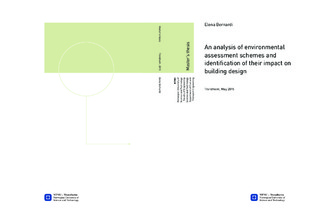| dc.description.abstract | The aim of this thesis is to present an overview of the available environmental assessment schemes in the building field, with the final scope of making an analytic comparison of the schemes.
The environmental assessment schemes are technical instruments having the target of evaluating the energy and environmental performances of buildings. Such schemes are specifically designed to assist the project management by providing frameworks with precise criteria assessing the environmental impact of the buildings.
The worldwide growing interest in sustainability and sustainable development had a remarkable impact on the building and construction industry. As a consequence, a large variety of assessment schemes have been established, each one with its peculiarities and fields of applicability. The present work is motivated by the interest in emphasizing such differences to better understand the assessment schemes. It also attempts to summarize in a user-friendly form the vast and fragmented assortment of information available. A deep comprehension of the state-of-the-art may lead to a more conscientious use of the schemes and allow to better identify the path for improvements and future research.
The total number of existing environmental assessment schemes is 78, these being not uniformly distributed around the globe. As a matter of fact, there are nations that have developed several schemes, such as France or US, while other nations currently have none, such as most African and Middle-Eastern countries. On the other hand, it must be noticed that some countries use only local adaptation of schemes originally developed elsewhere.
There are two main frameworks for the design of environmental assessment schemes, namely Life Cycle Assessment method and Multi-criteria Decision Making method.
The former is a quantitative method and allows to compile a rigorous evaluation of each environmental effect produced by the assessed building during its entire life cycle according to the scheme cradle-to-grave . The latter is instead a qualitative method and is characterized by a collection of environmental, economic and social information and data, which are evaluated by means of a rating system and then summarized to give an overall sustainability score of the assessed building. The analysis performed in the thesis is focused on the six main4 schemes based on Multi-criteria Decision Making method. These are: Building Research Establishment Environmental Assessment Methodology (BREEAM), Comprehensive Assessment System for Built Environment Efficiency (CASBEE), Deutsche Gesellschaft für Nachhaltiges Bauen (DGNB), Haute Qualité Environnementale (HQETM), Leadership in Energy and Environmental Design, and SB Method.
The analysis has been carried out by means of a series of tables illustrating different aspects concurring in the characterization of the schemes, such as project type, building type, categories and rating systems. The data used in the comparison have been collected from user manuals, official websites and research articles.
The final part of the thesis is devoted to analyze, on the basis of the same criteria mentioned above, two local schemes, BREEAM-Nor and Protocollo ITACA. | |

